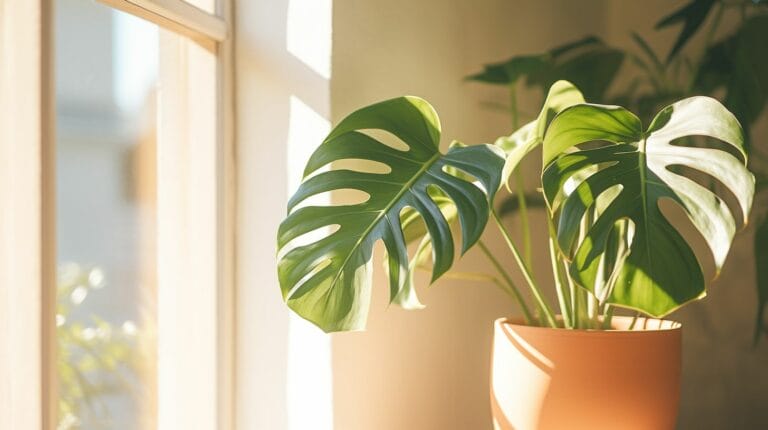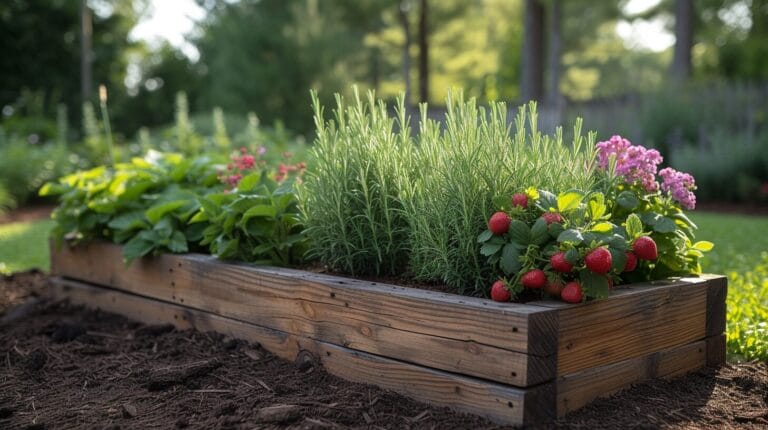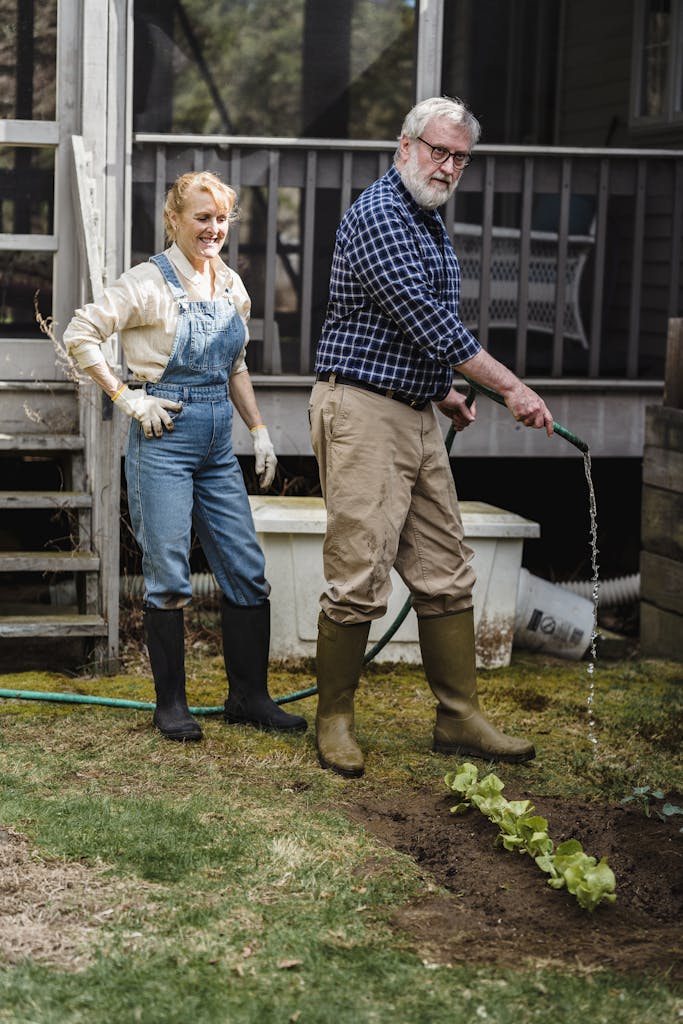Small Cherry Tomato Plant: A Quick Guide to Growing Tomato Varieties
Ever observed a tiny cherry tomato plant? As a gardening enthusiast, I frequently do. They begin as young sprouts, which I painstakingly groom into hearty plants that ultimately enrich the flavor of my meals. This process involves tackling pests, overcoming numerous gardening challenges, and drawing joy from bountiful yields.
I’m here to guide you on this journey, sharing my knowledge so you, too, can enjoy the gratification of growing your cherry tomato plant. Let’s embark on this exciting horticulture adventure together.
Key Takeaways
- Small cherry tomato plants are ideal for container gardening, making them suitable for small spaces and indoor cultivation.
- Proper pruning and care, such as removing lower leaves and pruning suckers, promote plant health and fruit production.
- Stakes and cages are essential supports for small cherry tomato plants, helping to keep them upright and maximize sun exposure and air circulation.
- Effective pest control, disease prevention through companion planting and regular watering, and addressing common infestations and diseases are important for the success of small cherry tomato plants.
Getting Started on Your Small Cherry Tomato Plant Journey
Let’s kick off our cherry tomato plant journey by understanding the different small tomato varieties – Grape, Cherry, and Tiny Tim. Choosing the right variety, such as Yellow Pear, Sweet Million, or Black Cherry, is crucial for a successful harvest. Whether you’re growing an indeterminate tomato or a determinate type, understanding their growth patterns will help in the growing season.
We’ll also explore the basics of indoor versus outdoor cultivation to help you decide what’s best for your gardening space.
Understanding Different Small Tomato Varieties: Grape vs Cherry vs Tiny Tim
I’m about to delve into the fascinating world of tiny tomato varieties, grape, cherry, and Tiny Tim, to kick off your journey into cherry tomato gardening. Understanding different tiny tomato varieties is crucial for any gardener.
Cherry tomatoes, with their small size and sweet flavor, are a favorite for many salad lovers. Also, grape tomatoes, slightly elongated and known for their firmness, are a popular choice. Then, there’s the Tiny Tim variety, a dwarf plant ideal for container gardening that can grow up to inches tall. Each of these different varieties has its unique characteristics, but all share the joy of compact size.
Your choice between small cherry, grape tomato, or Tiny Tim will largely depend on your personal taste and gardening conditions.
Tips for Selecting the Right Variety: Yellow Pear, Sweet Million, or Black Cherry?
In my gardener’s journey, it’s essential to know that choosing the right cherry tomato variety can make a world of difference in your harvest’s taste and yield. Yellow Pear, Sweet Cluster Tomatoes, and Black Cherry are all popular options. Some varieties are known to produce fruit earlier in the season, while others might require support like a tomato cage or vine support.
Yellow Pear tomatoes are bite-sized treats with a mild, sweet flavor.
If you’re in search of a prolific producer, Sweet Million might be your best bet. These varieties of cherry tomatoes are produced in abundance and burst with sweet, tangy flavor. On the other hand, Black Cherry tomatoes bring a distinct, rich, and complex taste to your table.
Basics of Indoor v.S. Outdoor Cultivation: Which Is Best for Your Gardening Space?
I’ve found that understanding the basics of indoor and outdoor cultivation can make or break your cherry tomato’s success, and it all hinges on your available gardening space.
Indoor vs outdoor cultivation represents two distinct paths. Growing tomatoes indoors, for instance, is ideal for small spaces. It involves container gardening and the use of a grow light to replicate sunlight. This method offers control over the environment, making it easier to manage infestations and diseases. However, one must be cautious of frost, which can be detrimental to the plants.
Picture your indoor garden, brimming with cherry tomatoes under the warm glow of a grow light. Imagine a compact container garden on your windowsill, a green oasis in a sea of city concrete.
Visualize stepping outside into a lush garden, the sweet scent of earth and tomato plants filling the air. Choose your path wisely, and embark on your cherry tomato foliage journey.
Taking the First Step: From Seed to Tiny Tomatoes
Let’s begin our journey by understanding how to grow tomatoes from seed. We’ll discuss the importance of sunlight, water, and fertilizer in ensuring strong growth. Then, I’ll share some strategies and best practices for achieving successful germination rates.
Planting Basics: How to Grow Tomatoes from Seed
Before we can enjoy the sight of micro tomatoes on our little cherry tomato, we’ll need to master the basics of growing tomatoes from seed. Here are the planting basics to grow cherry tomatoes:
- Starting, we’ll need some top-quality tomato seeds. Imagine holding the potential of countless juicy tomatoes in the palm of your hand.
- Next, we’ll sow these seeds in well-prepared soil. Picture the seeds nestling into the warm earth, beginning their transformation.
- Lastly, with a little sun and water, we’ll nurture these seeds into life. Envision the first green shoots breaking through the soil, a promise of the bounty to come.
Ensuring Strong Growth: The Importance of Sunlight, Water, and Fertiliser
To ensure strong growth, I’ll need a minimum of six hours of sunlight each day for my little cherry tomato and a consistent watering schedule, as well as the use of a good-quality fertilizer. Sunlight is essential as it aids in photosynthesis, the process by which the plant produces food for itself.
Water, on the other hand, helps to transfer nutrients from the soil to the plant. It’s important to maintain an optimal balance, as overwatering can lead to root rot. Meanwhile, fertilizer is key to providing additional nutrients that the soil might lack.
Successful Germination Rates: Strategies and Best Practices
I’ve discovered that achieving high successful germination rates involves a few key factors, and the right temperature is just as crucial as the correct moisture levels for my micro cherry tomato seeds. Here are some strategies and best practices I follow:
- First, I ensure to place the seeds in a warm location, ideally between 70-80 degrees Fahrenheit.
- Second, I maintain consistent moisture without overwatering, as seeds can easily rot.
- Lastly, I cover the seeds lightly with soil and keep the environment dark until they sprout.
These practices have helped me in successfully germinating my small cherry tomato plant from seed to micro tomatoes.
Pruning and Caring for Your Tiny Tomato Plant
Now, let’s turn our attention to the essential tasks of pruning and caring for your small cherry tomato foliage.
We’ll be discussing the art of pruning for optimal plant health, watering and fertilizing best practices, and the importance of supports like stakes and cages. Each of these elements plays a critical role in ensuring a bountiful and healthy harvest.
The Art of Pruning: Maintaining Optimal Plant Health and Production
Despite their size, I can’t underestimate the importance of proper pruning when it comes to maintaining the optimal health and production of my small cherry tomato. The art of pruning isn’t just about removing leaves; it’s a strategic process that promotes the plant’s overall growth habit.
I begin by identifying the main stem and removing the lower leaves, ensuring energy is directed towards fruit production. Then, I carefully prune the suckers, those tiny sprouts that grow between the main stem and the leaf stem. Lastly, I regularly check and clear out any dead or diseased foliage, which helps prevent the spread of diseases.
With careful attention to pruning, you, too, can master the art of maintaining optimal plant health and production.
Now let’s take a look at the real-life pruning process of small cherry tomato plants in this video:
Watering and Fertilizing: Best Practices for Small Tomato Varieties
Understanding the balance between watering and fertilizing is crucial for the health and vitality of my small cherry tomato. Here are my best practices:
| Watering | Fertilizing |
| Morning watering for moisture retention | Use a balanced fertilizer |
| Don’t overwater. It leads to root rot | Fertilize every 2 weeks |
| The soil should be moist, not saturated | Don’t over-fertilize, it can burn the roots |
| Use a watering can for control | Organic fertilizers are best for small tomato varieties |
| Water the base, not the leaves | Use a watering can to control |
Role of Supports: How Stakes and Cages Boost Your Cherry Tomato Harvest
While I’ve learned that watering and fertilizing are key to my small cherry tomato’s health, I’ve also found that using supports like stakes and cages can significantly boost my cherry tomato harvest.
These supports are more than just gardening tools – they’re my little plant’s personal bodyguards, trainers, and cheerleaders all in one. They:
- Keep the plant upright, preventing it from sprawling and potentially breaking its own branches under the weight of its fruit.
- Train the plant to grow in the desired direction, maximizing sun exposure and air circulation.
- Encourage larger, healthier fruits by reducing the plant’s energy spent on staying upright.
Addressing Common Pests and Dilemmas of Cherry Tomato Cultivation
I’ve grown a few cherry tomato plants in my time, and I can tell you that it’s not always smooth sailing. Infestations can be a real issue, and some diseases can affect the health of your plants.
But don’t worry, we’re going to address these common challenges and talk about how to overcome them, even if you’re growing your tomatoes indoors.
Identifying Common Pests: How to Protect Your Tomato Plants
In my many years of gardening, I’ve encountered a variety of infestations that can pose a serious threat to the health and productivity of my small cherry tomato. Identifying common infestations is crucial to protect your tomato greens and maintain a thriving vegetable garden.
Here are the most common infestations that I’ve dealt with:
- Aphids: These tiny insects suck the sap out of plants, causing drooping leaves and stunted growth.
- Tomato Hornworms: These large, green caterpillars devour tomato leaves, reducing the plant’s ability to photosynthesize.
- Nematodes: Microscopic worms that cause tomato diseases by attacking the roots.
Effective pest control is essential in maintaining the health and productivity of your small cherry tomato foliage.
Disease Prevention: Organic Measures to Keep Your Plants Healthy
Even though vermins and diseases can be common problems in cherry tomato cultivation, I’ll guide you through organic measures you can take to prevent these issues and keep your plants healthy. Choosing disease-resistant varieties of small cherry tomatoes is a proactive step in disease prevention. These strains have been bred to resist common diseases, reducing the need for chemical treatments.
Let’s look at some organic methods to deter infestations and diseases:
| Organic Measures | Effectiveness |
| Companion planting | Confuses pests, discourages them from settling |
| Regular watering | Prevents disease, keeps plants healthy |
| Crop rotation | Confuses pests, and discourages them from settling |
Implement these strategies to protect your precious cherry tomatoes. Remember, prevention is always better than cure!
Overcoming Common Challenges of Indoor Gardening
Often, I’m faced with the challenge of managing common vermins or pests in my indoor cherry tomato garden, but there are effective methods to overcome this.
Indoor gardening can indeed be tricky, especially when cultivating tomato varieties such as the small cherry tomato plant. However, overcoming common challenges isn’t impossible. Here are my go-to strategies:
- Regularly checking the potting mix for signs of vermins.
- Using a natural pesticide on the plant and surrounding soil.
- Ensuring the plant has optimal growing conditions to minimize stress.
By being vigilant and proactive, I can prevent infestations from invading my indoor garden and ensure my cherry tomatoes thrive.
Savoring the Fruits of Your Effort: Harvesting and Using Cherry Tomatoes
Now we’re getting to the really exciting part – reaping those juicy cherry tomatoes and using them in your kitchen. We’ll talk about the best time and methods to reap, as well as how to take care of your tomatoes post-harvest to ensure they last. Then, we’ll round it all off with some tasty recipe ideas to make the most of your bumper crop.
Harvesting Hints: When and How to Pluck Tiny Tomatoes
I can’t wait to share my tips on when and how to reap cherry tomatoes, essentially savoring the fruits of your hard work.
- The first hint is to observe your small cherry tomato plant closely. Ripe tomatoes have a vibrant red color and firm yet slightly soft texture.
- The second hint relates to timing. Cherry tomatoes are indeterminate, meaning they ripen throughout the season. Don’t rush to pick them all at once.
- Finally, towards the end of the season, even if the tomatoes aren’t fully ripe, you should reap them. They’ll continue to ripen indoors, providing a taste of summer during colder months.
Post-Harvest Care: Ensuring the Longevity of Your Tomatoes
After plucking the ripe cherry tomatoes, it’s essential to take proper post-harvest care, ensuring the longevity of your tomatoes and truly savoring the fruits of your effort.
Remember, the small cherry tomato plant you’ve nurtured from seedling is an heirloom variety and requires a bit more attention.
First, sort your tomatoes. Discard any with signs of disease or significant bruising. Then, store them at room temperature, away from sunlight, to retain their flavor and prevent over-ripening. For long-term storage, I recommend canning or freezing.
From Garden to Grill: Delicious Recipe Ideas for Your Bumper Harvest
Let’s dive into some mouth-watering, grill-ready recipe ideas to make the most of that bumper cherry tomato reap we’ve worked so hard for. I’ve got three delicious recipe ideas that’ll take your tomatoes from the garden to the grill in no time.
- Grilled Cherry Tomato Skewers: Thread your small cherry tomato plant’s fruits onto skewers, drizzle with olive oil, sprinkle with salt and grill. The intense heat intensifies the tomato’s taste.
- Cherry Tomato Bruschetta: Grill slices of bread and top with a mixture of chopped tomatoes, basil, garlic, and olive oil. Simple, yet bursting with flavor.
- Grilled Tomato Salsa: Grill tomatoes until charred, then blend with onions, jalapenos, and cilantro for a smoky salsa.
Savor your abundant reaps, friends!
Conclusion
Growing my own cherry tomato plant has been a rewarding journey. From sowing the seeds to tending the plant, battling vermins, and finally harvesting the fruits, every step was a learning experience.
Now, as I bite into these juicy, home-grown tomatoes, I can’t help but feel a sense of pride. It wasn’t always easy, but it was worth it. If you’re a gardening enthusiast like me, I’d say give cherry tomatoes a shot!
Frequently Asked Questions
What Are Some Recipes That Specifically Call for Cherry Tomatoes?
I often use cherry tomatoes in Caprese skewers, bruschetta, and pasta primavera. They’re also perfect for roasting with garlic and herbs. Their sweet, concentrated flavor and bite-sized nature shine in these recipes.
Are There Different Varieties of Cherry Tomato Plants?
There are various types of cherry tomato plants. Some popular varieties include Sweet Million, Sun Gold, and Rum Cherry. Each variety has its unique flavor, size, color, and growing requirements.
Can Cherry Tomatoes Be Grown Indoors or in a Container?
Absolutely! I’ve successfully grown cherry tomatoes indoors and in containers. They’re quite adaptable and thrive with plenty of sunlight, good drainage, and regular watering. Just make sure you pick a suitable variety for container growth.
What Are the Nutritional Benefits of Cherry Tomatoes?
Cherry tomatoes are highly nutritious. They’re packed with vitamins A, C, and K, and they also contain significant amounts of potassium and fiber. Additionally, they’re rich in antioxidants that can boost your immune system.
Can Cherry Tomato Plants Survive in Cold Climates?
I’d say that cherry tomato plants generally don’t handle cold climates well. They thrive in warm conditions. However, with proper care and indoor growing, it’s possible to grow them in cooler climates.







